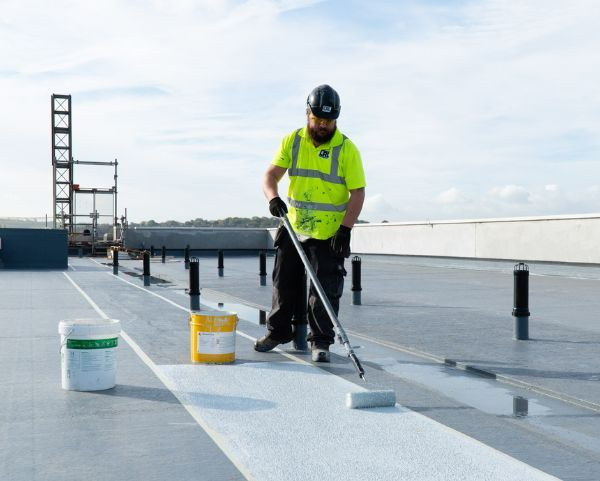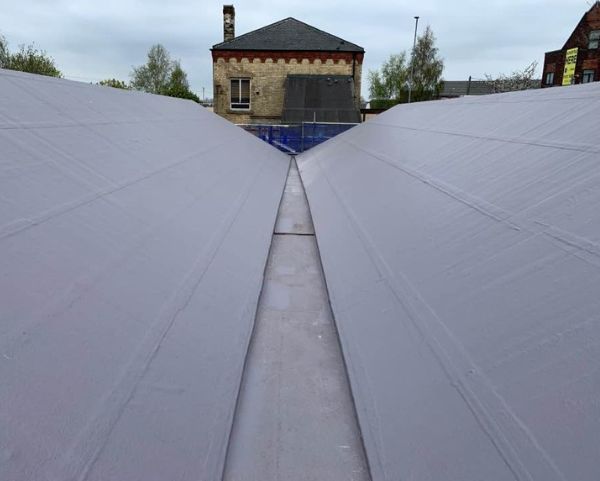Is a Cold Applied Liquid Roofing System Right for my Commercial Flat Roof?
Cold applied liquid roofing systems are widely used in commercial construction. They offer a range of benefits, including easy installation, excellent waterproofing performance and durability.
Cold applied liquid roofing systems can be applied to a wide variety of roof surfaces, including metal, and existing felt and asphalt, making them a versatile solution for many roofing applications.
When it comes to your commercial building, a well-installed waterproofing system can protect your building from water damage and extend the life of your flat roof. In this blog post, we will explore why it might be a good idea to use cold applied liquid waterproofing on your commercial flat roof.
Firstly, cold applied liquid waterproofing provides seamless coverage. Unlike traditional bituminous flat roofing systems, cold applied liquid waterproofing does not require seams or joints that can weaken over time and allow water to penetrate. Instead, a cold applied liquid waterproofing system is applied in a single layer that conforms to the shape of your flat roof, providing a watertight barrier that is more resistant to leaks and other forms of water damage.

Another advantage of cold applied liquid waterproofing is its flexibility. As your building settles and expands due to temperature changes or other environmental factors, traditional roofing systems can become damaged and begin to leak. However, cold applied liquid waterproofing is designed to flex with your building, providing a more durable and long-lasting waterproofing solution that can adapt to the changing conditions of your roof.
In addition, cold applied liquid waterproofing is easy to install and requires less maintenance. Unlike traditional flat roofing systems, which can be difficult and time-consuming to install, cold applied liquid waterproofing can be quickly applied with minimal disruption to your business operations. Once installed, a cold applied liquid waterproofing system requires little maintenance, which means fewer repair costs and less downtime for your business.
Moreover, liquid waterproofing is a cost-effective solution for commercial roofing. Traditional flat roofing systems can be expensive to install and maintain, especially if your building is large or has a complex roof design. Cold applied liquid waterproofing can save you money on both installation and maintenance costs in the long run although there are also benefits to using bituminous systems or single ply membranes from the outset.
Finally, cold applied liquid waterproofing is more environmentally friendly. Traditional flat roofing systems can generate a significant amount of waste during installation, whilst cold applied liquid waterproofing is a more sustainable option that produces little to no waste. Additionally, cold applied liquid waterproofing can help reduce your building's energy consumption by reflecting sunlight and reducing heat transfer through your roof. Moreover, another great benefit is that installation requires no heat source to bond, which can often become a point of contention on some commercial buildings due to fire safety issues.

There are many reasons why it may be a good idea to use cold applied liquid waterproofing on commercial flat roofs. Liquid waterproofing provides seamless coverage, flexibility, easy installation, low maintenance costs, cost-effectiveness, and environmental sustainability. If you are looking for a reliable and long-lasting solution to protect your commercial flat roof from water damage, cold applied liquid waterproofing is definitely worth considering as an alternative to bituminous systems.
With any flat roofing project however, it is good practice to consider your specific requirements, so please take a look and compare against the other types of systems.
Some downsides to consider in relation to cold applied liquid roofing are:
- Typically have a limited range of colour options and finishes, which may not meet the aesthetic preferences of some commercial building owners.
- Can sometimes be more expensive at the outset than other commercial roofing options, especially if multiple coats or layers are required.
- May require additional preparation work, such as cleaning and priming the roof surface, to ensure proper adhesion.
- They are usually a maximum thickness of 2mm and can be potentially affected by mechanical damage.








